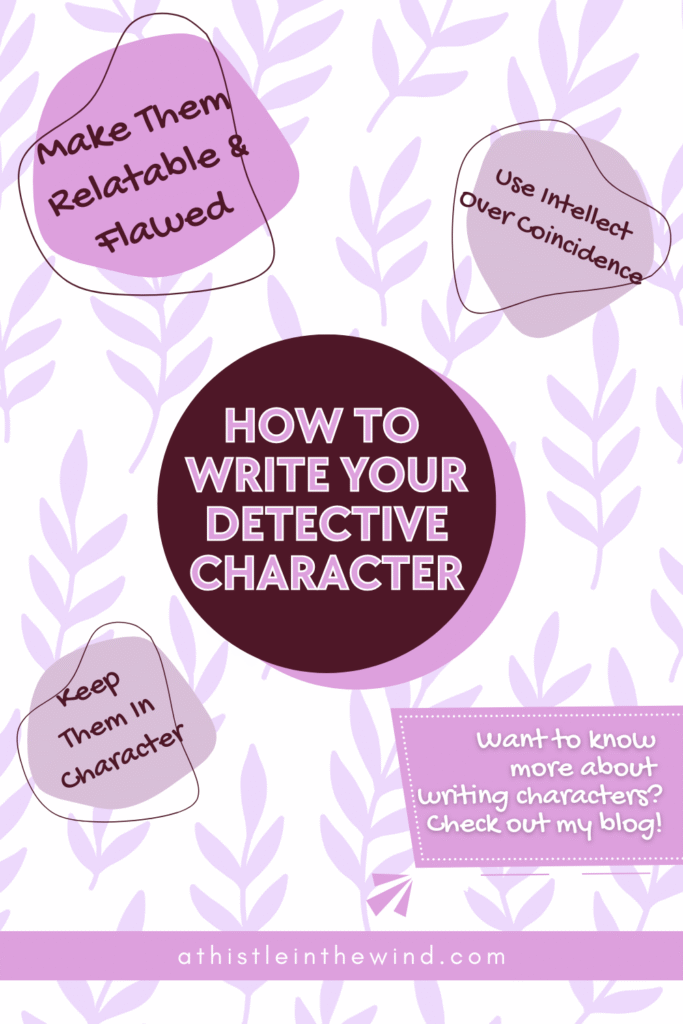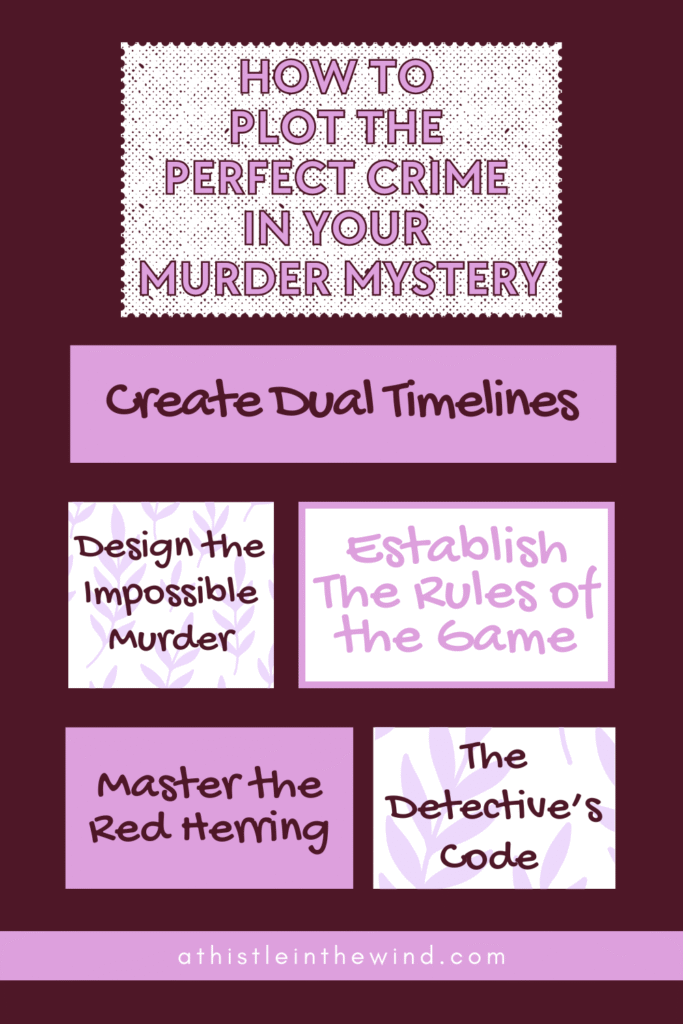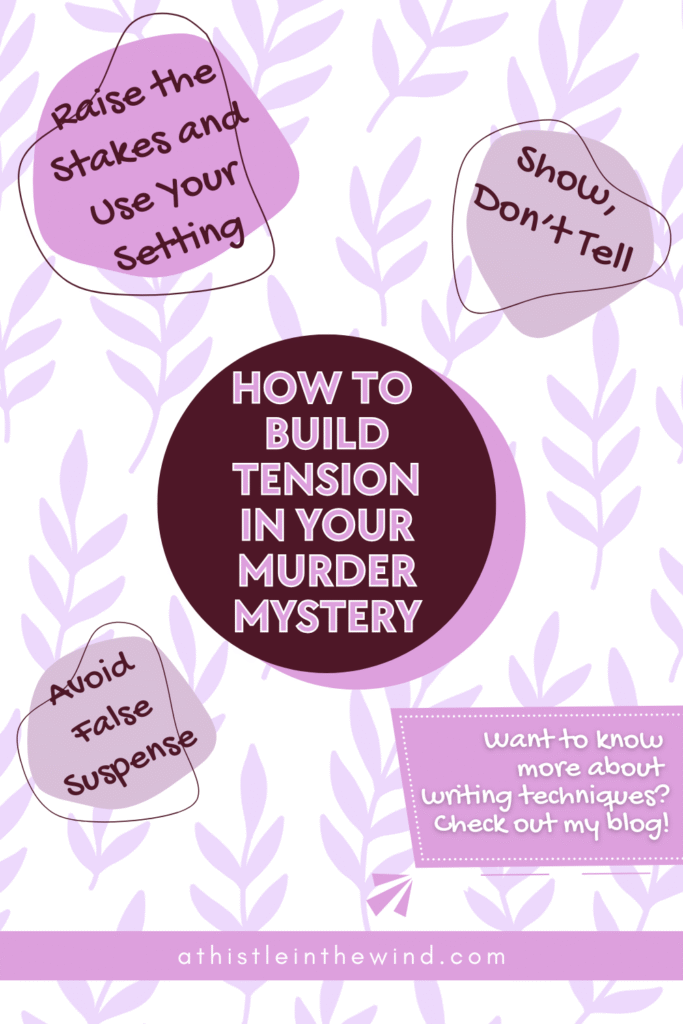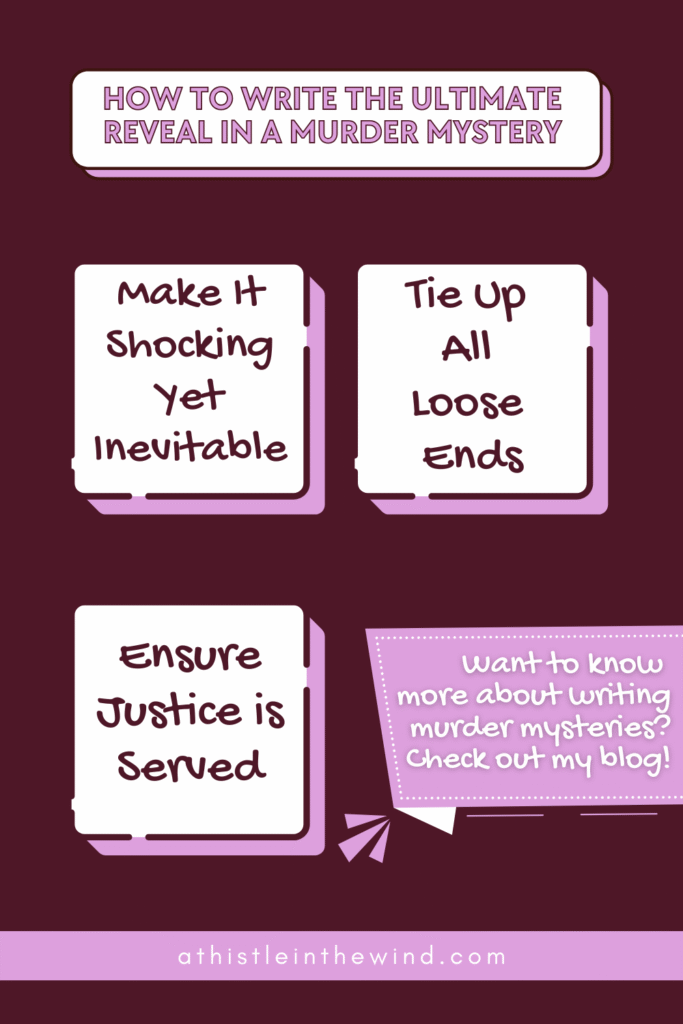How to Write A Murder Mystery

So, recently I’ve been watching and reading a lot of murder mysteries. It’s a fall thing really. When the weather gets colder and the cafes start serving pumpkin spice latte, I like to curl up with a good murder mystery.
You’ll see more of that in this month’s reading list.
Anyway, the point is, I like murder mysteries. But I’ve never written them before. I’m not sure I could, to be honest. At least right now anyway. I’m way too involved with my own manuscript to think of anything else at the moment.
But just because I’m not writing a murder mystery, doesn’t mean that you shouldn’t either. And help you out in your writing journey, I’ve gone ahead and done my little research on the topic. So, if you’re interested in learning how to write a murder mystery, this one’s for you.
In this blog, we’ll look at essential tips, techniques and more so that you can write a thriller that’ll hook your readers! Let’s begin.
How to Set the Scene and the Crime in Your Murder Mystery
As a writer myself, I understand that there are different types of writers out there, okay? And far be it from me to tell you how to plan your story.
However, with murder mysteries, you kind of have to establish your crime before you start your story. It could be vague, of course. But the crime, the victim and the nature of the murder itself are critical components that you need to have a very clear idea of.
If you don’t then you can’t create a story around it.
Choose the Perfect Victim
Your victim needs to be perfectly suitable—almost made for—the manner in which they’ve been killed. Also, and this is a popular trope I’ve seen in many books, the more controversial your victim is, the more suspects you can come up with.
It’s best to have a victim who’s completely interconnected with every other character in your story. In Knives Out, the victim—Harlan Thrombey—had a reason to be killed by any and all of his children and grandchildren. Similarly, in Murder on the Orient Express by Agatha Christie, it’s revealed that all suspects had banded together.
You can also flip this trope on its head. When watching Glass Onion, the initial impression I got was that the billionaire, Miles Bron, was the obvious target. It’s later that we find out who the actual victim was.
Once the victim is established, move on to the practical details of the crime. Think about the where, when, and how the body was found. Consider the weapon used and whether any crucial evidence was left at the scene.
The Importance of a Closed Environment
A crucial component in the classic murder mystery tradition is the “closed environment.” This clever device allows your detective to carry out their investigation, collecting and keeping track of their list of suspects within reasonable bounds.
When creating your closed environment, you have many locations to choose from: it can be a big city, a small town or even the parameters of a family estate.
Classic examples of closed environments are often isolated locations, such as an island, preferably one cut off from the mainland by problematic weather (something we say in Glass Onion by the way).
An isolated country house works wonderfully too, especially if the WiFi is mysteriously disconnected. The deluxe package, if you can manage it, is an isolated castle on an isolated island, cut off by weather.
However, remember that a closed environment doesn’t necessarily mean remote. It can simply be a space that traps your suspects together, such as a busy apartment building in the heart of a major city or even a high-season resort in the Bahamas. The key function is containment.

How to Populate Your Story with Characters and Suspects
Once you’ve established the victim, crime and location, you need characters to fill out the rest of your story.
Create Complicated Suspects
Your murder victim is only the beginning. To keep your readers engaged, you need to create a web of complex and believable supporting characters. Every suspect must have a strong motivation for committing the murder, an interesting and relevant backstory, and, crucially, something to hide.
If only the murderer was concealing information, the case would be far too straightforward. Consider Agatha Christie’s Murder on the Orient Express. That book presents a whole cast of characters aboard the train, each with compelling backstories, secrets, strong motivations, and a unique connection to the victim.
As you develop your cast, remember these four essential elements:
- Motive: What would your suspect gain from the victim’s death or what terrible slight are they looking to avenge?
- Opportunity: Where were they when the crime took place? Did they have access to the murder weapon?
- Connection: How do they know the victim and what is the nature of their relationship?
- Alibi: Each suspect needs a seemingly valid alibi for their whereabouts at the time of the crime.
Remember, giving your characters depth always pays off. Crime is inherently human, and the answer to any mystery always lies in understanding the characters involved.
The Suspect Sweet Spot
Balancing your list of suspects is a tricky art. You need enough dodgy side characters to pose a suitable challenge to the reader. Too few, and the plot will feel obvious. Too many and your reader can get confused, paging back, muttering, “Who was that again?” when a character last mentioned on page 11 reappears on page 226.
While there is no magic number, generally, having at least three suspects is smart. Make sure every character is distinct and well-rounded. The more vivid they are, the easier it will be for your reader to keep track of them.
Note: Avoid giving characters similar-sounding names. If you introduce characters named Rupert and Robert, or Jane and Joan, you risk readers throwing your book against the wall in frustration (Unless this is on purpose of course).

Introduce Your Protagonist (the Detective)
Your protagonist, the detective, is the person your reader will identify with as they attempt to solve the murder. They are the human element that makes the story relatable.
This character doesn’t always have to be a famous detective (though Sherlock Holmes often comes to mind when thinking about them) or a hard-boiled private investigator like Mr. Poirot. They can be an inquisitive novice or an amateur sleuth, such as Agatha Christie’s Miss Marple.
While your detective might have flaws and secrets of their own, they should be someone the reader can sympathize with and root for. Your reader will automatically treat the protagonist as a co-detective. An intriguing backstory is a great way to hook readers and generate sympathy.
It is essential that your detective uses their intellect and skills to solve the crime.
Dorothy Sayers authored an oath for the Detection Club, requiring members to pledge that their detectives would “well and truly detect the crimes presented to them using those wits which it may please you to bestow upon them.” They are expressly forbidden from relying on “Divine Revelation, Feminine Intuition, Mumbo Jumbo, Jiggery-Pokery, Coincidence, or Act of God.”
If your protagonist does experience a burst of intuition, ensure it is grounded in their specific background and experiences. Seriously, you can literally have a psychic or medium solving a case.
Side Note: Actually, that’s a good idea for a story. I’ll look into this.Also, remember to keep your characters in character. If your detective, like Poirot, relies on his “little gray cells,” he probably wouldn’t go down a creepy old stair until an assistant dusted off the cobwebs first. If they must act out of character, you have to give a good reason and make it a crucial part of their character development.

How to Plot the Perfect Crime (Work Backwards)
Intricate plots do not happen by accident. While you can have a lot of fun with your initial brainstorming, the hard part is figuring out how your detective will ultimately reveal the solution.
Create Dual Timelines
When planning your story, it is often easier to figure out the plot backwards, starting at the moment of the big reveal and mapping out the preceding events in reverse. J.J. Connington likened this reverse plotting process to composing a chess problem: the constructor starts with the checkmate position and then devises the moves leading up to it.
Your murder mystery essentially consists of two separate stories:
- The Story of the Murder: This narrative, including the killer’s actions, should be revealed to the reader only in bits and pieces throughout the book.
- The Story of the Detective’s Investigation: This must be told chronologically to ensure the reader has a fair chance to solve the mystery along with the protagonist.
To ensure there are no gaps or logical inconsistencies, you should create a detailed, chronological timeline of all the events, no matter how small. Flesh out each point by asking:
- What happened?
- Who was involved?
- Where, when, and why did it occur?
Design the Impossible Murder
This is where you make the crime your own. You must create a unique twist on the actual murder that will surprise your readers and keep them guessing until the end. You could change the motives, such as making the killing about insurance money or a love triangle gone wrong.
Or you might alter the method—poisoning instead of a bullet, or drowning instead of bludgeoning.
Whatever you choose, aim to include a feeling of improbability or impossibility to the crime. This sense of the unbelievable increases the mystery and engagement.
For example, the investigation in Arthur Conan Doyle’s Hound Of The Baskervilles focuses on a series of murders committed on desolate moors, where the initial culprit appears to be a ferocious, supernatural hound. This layer of the impossible ensures immediate intrigue.
Establish The Rules of the Game
When reading your murder mystery, readers always come prepared to play the game. At least that’s what my sisters, friends and I do.
So for this to be satisfying, you have to make sure that it’s fair. This means that while misdirection is permissible, concealment is absolutely not. I cannot stress the importance of this enough.
All clues essential to the solution must be shared with the reader. You can certainly drop subtle hints or distract them by “whispering, ‘Never mind that little fabric scrap behind the curtain,’” while flashing daggers at them to make them look away. But the clue must be present on the page.
In 1929, Ronald Knox, a founding member of the legendary Detection Club, laid down strict rules for detective fiction, the most quoted being that “The detective must not light on any clues which are not instantly produced for the inspection of the reader.”
This is fair play.
You cannot produce previously unknown twins or hide a key piece of evidence until the last chapter; doing so is not just unfair, it is lazy writing.
The solution must be attainable, at least in hindsight. The reader should have the same information as the detective, ensuring they don’t feel cheated out of the opportunity to solve the crime themselves.
For instance, Sherlock Holmes’ famous deductions are always based on observations that perceptive readers could, in theory, make themselves.
Master the Red Herring
A murder mystery isn’t truly mysterious if the reader solves it long before the final pages. To prevent this, you need plenty of red herrings.
A red herring is a false clue planted specifically to point the reader in the wrong direction.
These can be done in various ways: physical evidence that seems to incriminate a suspect but is later revealed to have been planted, or eyewitnesses who give conflicting testimony. When planning your suspects, always consider the clues and red herrings you want to include.
However, use them sparingly and strategically.
Too many red herrings can make the story feel like a wild goose chase. A good practice is to ensure that every false clue serves a narrative purpose, such as deepening the story’s themes or revealing a character trait.
Be careful not to cross the line between misdirecting the reader and outright duping them. Duping involves veering onto an entirely new road that makes the solution feel impossible to piece together.
Agatha Christie was legendary for her artful misdirection, often using elegant sleights of hand—like a seemingly routine one-sided telephone call—to hide the truth without explicitly lying, ensuring the reader never feels cheated.
The Detective’s Code
The best mystery writers know that the core of the puzzle must be sound, avoiding contrivance. While some books might include “feminine intuition, coincidence, jiggery pokery, or the odd deus ex machina,” the key is that these moments must make perfect sense within the context of your plot.
Side Note: I personally find the term 'feminine intuition' to be quite annoying. Anyone can have intuition but these are direct quotes from the Detection Club so we must bear with them.If a dea ex machina (an unexpected character or event solving the problem) appears, ensure it’s not completely out of the blue. It should be a character you’ve been hearing about throughout the book.
In short: don’t be lazy. Rely on the little gray cells of your detective, not cheap tricks.

How to Build Unbearable Tension
The difference between a good mystery and a great one is the constant flow of suspense that keeps the reader on the edge of their seat.
Raise the Stakes and Use Your Setting
Continuous suspense is vital. A simple way to achieve this is to always raise the stakes. Ask yourself:
- What terrible thing will happen if the mystery isn’t solved immediately?
- Will more people die, as in Agatha Christie’s And Then There Were None?
- Will the wrong person be convicted?
This sense of urgency heightens the tension dramatically. Your setting choice can also have a massive impact on suspense.
A dimly lit mansion with countless rooms during a thunderstorm automatically feels tenser than an open-plan, sunny kitchen. The desolate moors of Devonshire in The Hound of the Baskervilles are a perfect example of an eerie setting contributing to suspense.
You can also build suspense by varying the pacing. Alternate between fast-paced, high-stakes moments and slower, reflective scenes. This rhythm keeps readers engaged while allowing them a moment to catch their breath and process the clues. And don’t forget the power of the cliffhanger at the end of a chapter, leaving your reader desperate to keep turning pages.
Show, Don’t Tell
Yes, I know. We’ve talked about this multiple times in the past. But it’s super important.
This is a mantra for all fiction, but particularly critical in mysteries. You must engage your readers by immersing them in the story, not just narrating events. Use vivid descriptions, dialogue, and actions to reveal key details and drive the plot forward.
For example, instead of telling the reader, “The victim was poisoned,” you should show your detective observing a half-empty glass with a strange residue. Allow your characters to reveal their secrets, motivations, and personalities through their own dialogue and actions. Snippets of overheard conversations or confrontational interrogations can brilliantly serve as both character development and plot advancement.
Avoid False Suspense
As you build tension, be wary of falling into the trap of “false suspense.” This happens when you withhold information solely to appear mysterious. If you spend paragraphs writing about a character’s “vague unease and unplaced frustration,” hoping to intrigue the reader, you are teasing, not writing a compelling mystery.
Good writers know that the opposite is true: the more generous you are with information, the more the reader will want to know. Withholding information creates a distance from the character’s feelings, and the eventual reveal has enormous pressure to be worth the trouble.
What truly captivates us is the great human mystery: how people behave in response to a situation, and how personalities clash and draw each other out.
Finally, you must start strong with an engaging hook. Your opening needs to grab the reader’s attention immediately. Whether it’s the dramatic murder scene itself, an intriguing character, or a vivid setting, make those first pages unforgettable.
The Murder of Harriet Vane by Dorothy L. Sayers, for instance, opens with high tension and stakes as Lord Peter Wimsey sets out to clear Harriet’s name from a murder accusation, immediately pulling the reader into the question of her innocence or guilt.

How to Write the Ultimate Reveal in Your Murder Mystery
After spending copious hours plotting and misdirection, the conclusion of your murder mystery must satisfy the reader and provide ultimate clarity. Here’s how you do it.
The Shocking Twist
A murder mystery is only as strong as its plot twist. The best twists are entirely unexpected, but when you look back, they should make perfect sense. They should force the reader to re-evaluate everything they thought they knew.
To ensure inevitability in hindsight, you must subtly plant clues throughout the story that point toward the twist. When the big moment arrives, the reader should be left thinking, “How did I miss that?”
For example, one of Agatha Christie’s novels redefined the entire genre because the narrator himself turned out to be the murderer. Though readers are now more wary of unreliable narrators, with the right amount of sophisticated misdirection, a twist of this magnitude can certainly be pulled off again.
A Satisfying Resolution
Since you planned your story backwards, you should know exactly what happened. The ending must be satisfying, providing closure with all loose ends tied up neatly. You achieve this by providing a credible, logical explanation for all the clues that were left throughout the narrative.
The ending of your murder mystery should feel earned through the intellectual efforts of the detective (and the reader), not through an unpredictable or contrived coincidence. You must ensure that justice is served, and every character who plays a role gets their due comeuppance.
If you find yourself stuck during the writing process, remember: the writing process can sometimes feel like driving at night in the fog. You can only see as far as your headlights, but you can make the whole trip that way.
Keep asking questions of your plot and lean into the puzzlement of it all. That delicious struggle will undoubtedly pay off for both you and your readers.

And It’s A Wrap!
Not sure if I’ve used this as a heading before (I think I have), but that’s all on how to write a murder mystery. Yes, I did add the keyword for SEO purposes. Okay? This blog’s been doing really well on search console recently and I’m determined to keep the momentum there.
Anyway, doing research for this blog was interesting. I really like murder mysteries, mysteries, crime fiction—the whole shebang. But I never thought that, frankly, I had the capacity to actually write something like it. I mean, my idols (and I do not use that word lightly) are Arthur Conan Doyle and Agatha Christie in this genre, okay?
I’ve gone to the Pera Palace multiple times to tap into her energy, so that I can write as well as her. And don’t get me started on ACD. I will probably end up spending a day walking around London at some point in the future, just to understand how he wrote Sherlock Holmes.
Might sound cheesy, but I truly believe that if he hadn’t written Sherlock Holmes, we would’ve never had a character like that. I’m kind of plagiarising Neil deGrasse Tyson here but I do think that with the laws of physics (tell me you’re back in uni without telling me you’re back in uni), someone would’ve discovered them even if Newton or Einstein weren’t born. Because those are facts of the universe. But writing? Art? Nah, no one would’ve delivered Sherlock Holmes to us.
Use this motivation as a reason to write today. Because you don’t know how great your story will be and how it’ll impact people. So, don’t give up.
Let me know what you think about this in the comments! My next blog’s going to be up soon!
